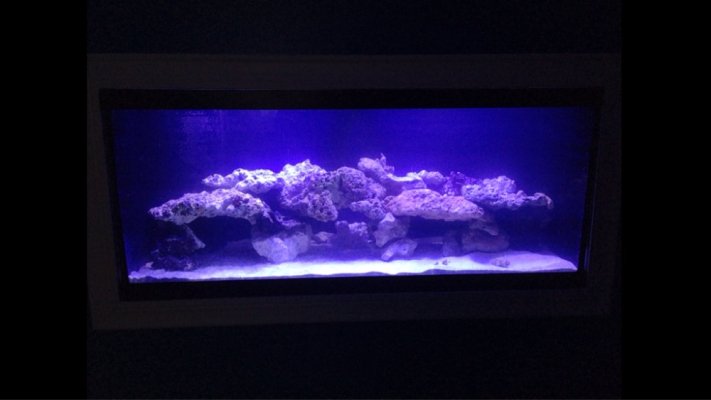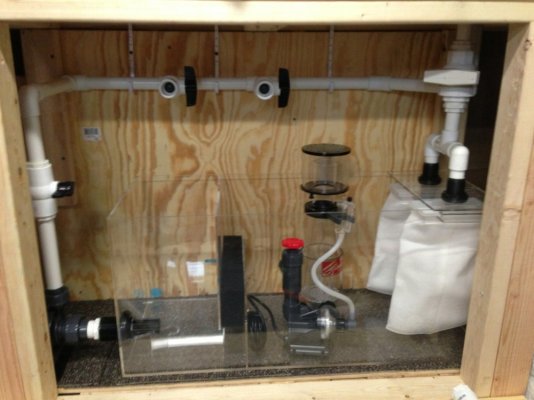Not to beat a dead horse ( where's that stupid Icon for beating a dead horse when I need it? lol

) I'd like to expound on a few things. Please don;t take these as criticism or as being spoken only to you. I hope that the following is more of a learning post for all that are reading this and NOT a blaming post.

Back in the 70s and 80s, ( I'm old

and I've been in the fish biz for over 40 years

) there was a book titled " The marine aquarium in Theory and Practice." It was one of the best books of it's time as it talked about what you needed to do in a marine aquarium as well as the WHY you needed to do it. ( I haven't seen too many internet pieces that are as inclusive as this book was. I only wish is was still in print.) It cost about $20.00 at the time and I made every potential saltwater customer buy it and read it before they started their tank so they would know what was going on in their system and not have to depend on me or the store being open at all hours of the day & night to fix things that might go wrong.
I'm not going to get into the technicals as you , Dino, WY Renegade and the other posters here have pretty much got the technicals posted. This is about the practice of the technicals.
For starters, the OP did not say what sized tank they were talking about in this thread. From there, without knowing the size of the tank or what the eventual makeup of the tank will be, there could be ( and are) many options available for the OP. As to which is best, ( the original question I believe), this is where the application of the technicals comes in.
A cycled aquarium just means that there are enough nitrobactors and nitrosomas ( or any other type of BB) to convert the ammonia waste in a system into more harmless nitrates and depending on your system, potentially converting/ removing those nitrates out of the water system entirely. So, for example, if you were to take a 30 gal tank that has matured and is stable with say, 3 fish in it, and you upgraded the tank to a 300 gal tank and put all the gravel, decor, fish, filters and filter materials from the 30 into the 300, you would have a fully cycled 300 gal tank instantly. There would be no need to add extra ammonia or ammonia producers to cycle the tank. HOWEVER, it's cycled for those 3 fish NOT a fully stocked to capacity 300 gallon tank. This is where the "slow and steady" version of adding stock really needs to be used.
If you use a "fishless" method of cycling a new aquarium, once the ammonia level introduced into the system has been converted, as previously posted, there is a limited time frame for the aquarist to replace the same amount of ammonia production in order to keep that sized BB bed alive as it is a living breathing "organism" that grows and contracts to it's food source ( ammonia). Regarding your post: "As for the 4ppm, it creates a strong enough colony of bacteria to handle what most people would stock their tank with.", 4 PPM is a concentration not an amount. I could get a 4 PPM reading in a thimble of water yet there would not be any way for fish of any quantity to live in there. So I think you are a bit misled as to that theory.
Regarding your comment : ".25ppm of ammonia from the rock will do nothing.", How do you know that the rock will only produce .25 ppm concentration of ammonia? That can only be determined by the amount of dieoff on the rock and the amount of water the rock is being put in. Again, you are making assumptions without parameters to qualify. This seems to be a typical thing within the online hobby portion of the hobby. There is no hard and fast rule that says " A certain sized piece of live rock will produce X amount of ammonia when being moved from point A to point B." There are just too many variables to make that kind of statement. The same applies to the BB within the rock. These are guestamations at best and shouldn't be considered the rule. Only the test kit tells you when you have enough for the bioload you are keeping within the tank. Obviously, the more rock you have, the more places for that BB to live within. HOWEVER, do you need a lot of rock if your bioload is small, no matter what size tank you have? See my point?

As for noone ever putting 20 damsels into a tank at one time, Yes they do. We used to cycle new 100 gallon or larger tanks with as many as 200 damsels. The thing is that once the tank cycled, we would know that there were enough bacteria in the tank at that point to handle 200 ( or whatever amount was still alive) 1"-2" fish so removing these fish and adding a number of other fish that equaled ( or as closely as possible) the ammonia production of those fish would not be straining the bacteria bed. Again, this is applying the technicals because it also stands to reason that should you do 10 damsels in that 100 gallon tank and it cycles, there would only be enough BB for those 10 fish not a fully loaded 100 gallon tank. So that 4 ppm is just a concentration and can hardly be figured as the "Gold Standard". Maybe it was thought of as a way to get people to buy more fish once the tank cycled? Then again, how many fish would that be unless you knew how many fish and what sized fish it would take to produce the level of ammonia in the tank that just finished cycling 4 PPMs worth of ammonia? Again, too many variables.

As for the posted article mentioning not using fish in today's hobby but using live rock instead, Don't get me started!!!! lol Why are the living organisms on the rock less deserving than fish when cycling an aquarium? I have had many Damsels survive for many years after being the fish to cycle tanks. No, you can't put and expect to survive, any fish you want in to cycle an aquarium but there are some fish that can handle is as good as if not better than some inverts living on live rock. But that's another story for another thread


Bottom line is that there are many ways today to start a tank. Is one better than another? Maybe, maybe not. It may just depend on which era you got into the hobby in. But they all have the same goal in mind so I don't believe it really matters. What matters is that the hobbyist understands what's happening in the tank and doesn't force things that create instability within the system or rush things that create instability. The good news is that no matter what method one uses, even if they screw it up really, really, really bad, given enough time, the tank will correct itself and become a pristine environment again. You just have to be willing to wait it out.

It IS more fun tho to not have to do that.

I hope this helps




 and I've been in the fish biz for over 40 years
and I've been in the fish biz for over 40 years 